The following was a project to keep me busy during Covid-19 lockdown, parts were originally posted by me on the Achilles Flickr site with other information coming from contemporary documentation.

The Achilles 9m was designed and built by Chris Butler (Butler Mouldings), previously known for building the Achilles 24 and rather heavy 505 and Fin dinghies. About 100 were built between 1975 and c 1984. Many were home finished usually but not always from kits, these covered individual aspects so interiors and fittings can vary a bit. The robust hull, deck and other key mouldings and parts were assembled and bonded together in the factory so structural integrity was consistently good across the fleet. As far as I can tell Osmosis is unheard of on Butler boats, at least those used on salt water and not left flooded with fresh water. Chris Butler attributed this, at least partially, to not using pigment in the epoxy mix below the water line but I suspect it is more to do with careful lay up and a slow cure - osmosis is often found on boats which can be shown to have had excess hardener in the mix..
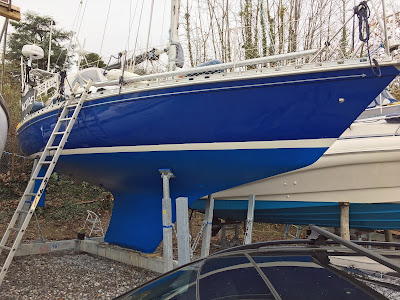 |
Sancerre after winter maintenance 2019/20 showing the fine entry
and the sweep down to the keel. |
 |
A good view of the profile whilst launching at Deacon's yard
April 2021, delayed a month due to Covid-19. |
 |
Nothing flat about Sancerre's
bottom! |
Sancerre's fin and skeg arrangement is the more common configuration, a shallow draft "triple keel" variant capable of drying out was also available with a shortened central keel and large bilge keels with performance close to the fin keel version. Both have a "proper" bilge with a sump so can be kept as dry as any.
The fine entry and initial lack of buoyancy forward means she can pitch more than modern flat bottomed designs but the "V" form back to the keel and the rapidly increasing form stability as the bow drops means she does not normally slam into waves unlike so many of the more modern designs so your fillings should stay in place. Also is has to be seriously bad conditions for the bow to dig into an on coming wave, after more than 17,000 nautical miles at sea I could probably count the number of times it has happened to me on the fingers of one hand.
Considering the low freeboard, they are surprisingly dry in a blow but beating hard in a F6 or more in a sea way there may be the odd wave coming down the side deck, fortunately the cockpit coaming will keep them out of the cockpit but dodgers and certainly a spray hood are to be recommended for serious offshore sailing. The low freeboard makes mooring and berthing easier, and it is easy to get aboard from a pontoon or dinghy.
If you want to go quickly upwind you will have more heal than beamier designs but unlike contemporary more extreme IOR designs, she will maintain directional stability and unlike modern boats with maximum beam maintained towards the stern there is no need for twin rudders to prevent a windward broach!
Initially the boat is quite tender but as she heals she stiffens up quickly and will then be stable with the rail clear of the water - that is not as much heal as it first seems due to the low freeboard. They are quick compared with most cruisers from the 70s and 80s, from a contemporary review:
"The other big surprise was the sparkling performance of the little Achilles, the smallest boat in the rally which finished [the 22 mile race] 4th [from 10]",
 |
The swept back trailing edge is a common
feature of skeg hung rudders of the period
to increase rudder authority but it does not
help steering when going astern. |
she was beaten home only by boats 2 - 3 feet longer in force 6 conditions, the full report is available on the
Achilles owners association web site here. An Achilles would not stand a chance against a good half tonner (c30ft LOA) of the period with a competent crew - but you would not want to cruise most of those anyway and certainly not short handed.
The fin and skeg design together with the swept back trailing edge of the rudder and powerful engine with a big 3 bladed fixed prop means that handling astern is not brilliant but with practice and intelligent anticipation the prop walk can be used to your advantage and, touch wood, I don't have any particular problems in marinas.
The type is a very capable small offshore boat, especially for the single or short handed yachtsman, and a good number have been to the Azores, to and around the Mediterranean and across the Atlantic.
 |
Three A9m's at the end of the 2019 single handed Jester Challenge,
an event for boats nominally between 20 and 30 feet although
a good number for this event were rather bigger.
|
The
2019 Jester Challenge to Baltimore (IRE) (JBC) was not a race but Duncan in A011 "Freebird" (left in the picture) was first to arrive having started from Pwllheli (minimum distance 227 NM), A021 "Sancerre" (right) and I were second in and first from Plymouth (minimum 261 NM) after 76.5 hours sailing. Centre is A059 "Tranquillity", a triple keel variant, Mike also started from Plymouth and was not far behind, especially when considering that after a wind shift he was caught down tide going into the Fastnet.
 |
| Coming into the Fastnet from the SSE, Cape Clear behind. |
Three A9m starters and three finishers in a tough event that started with very rough seas and a F6 wind that was followed by a dead calm west of the Scillies. More than half the fleet retired or deciding not to go at the last moment.
My blog entries covering the event can be found here, several of the blogs referenced on the list on the side panel also have accounts.
"The Achilles boys are a close knit Jester clan rightly proud of their craft. You buy an Achilles for a Jester because they are the right size; because they are old and therefore cheap; because they are tough and achingly pretty but mostly because they are fast. Yes you buy an Achilles to win! John [me] had told me his result with a true competitor’s glint in his eye. “Good boats” I said” but better sailors”, thinking as I said it of Pippin lugging Willis’s stores around. No the Jester Challenge isn’t a race, of course it isn’t."
This did not make it into John's version published in Yachting Monthly (Jan 2020) "To Baltimore with the Jester Boys", although I got a couple of mentions and a pic, you may still be able to find it for free on Google.
At the time of writing, (winter 2020/21) and Covid-19 permitting, three A9m's are likely to be sailing in the 2021 JBC, Mike and I again and Tony in Red Marlin. Having done one from Plymouth I am likely to start this one from Pwllheli and am hoping we don't have 2 or 3 days of south westerly winds. If it should be rescheduled Mike and I are also entered for a potential 2021 Jester Azores Challenge (JAC) but for various reasons I am at best 50:50 for that.
Update: Due to Covid a 2021 JAC was "on" and mainly "off" through the early months of 2021 and finally "on" well after I had left on my anti-clockwise round GB trip. The JBC was cancelled and replaced with an event round a virtual turning mark in the Celtic Sea finishing in Milford Haven, I tried to make the start from Pwllheli but bad weather held me up and I missed it, although I did meet up with some of the finishers in Milford.
Principal Dimensions.
Length Over All (LOA) 29' 10"
Waterline Length (LWL) 25' 5"
Beam 9'
Draft 5' 6"
Designed Displacement 7,000 Lb
Keel ballast 3,000 Lb
The theoretical hull speed is 6.81 knots and for the traditionalist, she is 9 Tons Thames Measurement.
The Capsize Screening Number is 1.82 (CCoA "Capsize project formula", Olin Stephens et al., following the Fastnet Disaster in 1979) a number less than 2 is considered appropriate for serious offshore sailing although modern designs are often well above this number and manage OK.
Rig
Masthead with single spreaders that have no sweep back plus fore and aft lowers. Standard fit was a Proctor mast with through mast round boom roller reefing, now made redundant on Sancerre by much more efficient two line slab reefing.
 |
The in line spreaders together with the 2 line slab reefing
means that the mainsail can be reefed from the cockpit
on any point of sailing. Pictured off St Mawes, 2019. |
| Principle Rig Measurements | Feet | Metres |
I | Jib halyard sheave to toe rail | 35.03 | 10.68 |
J | Mast to forestay pin. | 11.34 | 3.46 |
P | Max mainsail Luff | 30.93 | 9.43 |
E | Max mainsail foot | 9.24 | 2.82 |
FSL | Forestay Length | 36.9 | 11.3 |
Original spec: 1x19 stainless wire:
Cap shrouds, forestay & backstay 7mm.
Lowers 6mm.
Sails
Data from a 1977 brochure or calculated from it (e & oe!)
|
|
Square
feet
|
Square
Metres
|
Sancerre
Sq m
|
|
Mainsail
|
143
|
13.3
|
13.3
|
|
No 1
Genoa (150%)
|
313
|
29.1
|
c 29
|
|
No 2
Genoa
|
247
|
22.9
|
n/a
|
|
No 1
Jib
|
174
|
16.2
|
12.1
|
|
Heavy
weather jib (max under World Sailings Offshore Special Regulations)
|
165
|
15.4
|
|
No 2
Jib
|
62
|
5.8
|
5.7
|
|
Storm
jib (max under World Sailings Offshore Special Regulations)
|
61.4
|
5.7
|
|
Spinnaker
(Theoretical max)
|
732
|
68
|
60 (Full radial)
|
|
Spinnaker
(Original "floater" option) other options smaller
|
624
|
58
|
|
Small Star
Cut Spinnaker
|
|
|
??
|
|
Full Radial Cruising
Shute (Approximately a heavy Code 3 asymmetric spinnaker)
|
n/a
|
n/a
|
c 45
|
|
Tri-sail
(special regs max)
|
50
|
4.65
|
3rd reef
|
Head sails would originally have been hanked to the stay or possibly in a twin slotted foil, like most cruising boats Sancerre now has a roller furling headsail, the genoa works tolerably well down to about the size of the originally specified No 1 jib and the "Special Regs" heavy weather jib requirement, albeit without the independent stay fastening. However, after being very unlucky with strong head winds on the Jester Baltimore and my round GB trips I acquired a 12.1 sq m heavy weather jib for the 2022 season to be hoisted on a removable Dyneema fibre stay just behind the forestay.
Sancerre does not carry a storm tri-sail but has a third "storm" reef in the mainsail (added since most of the pictures on here), which is easier to rig than a try-sail and is about the same size, having folding mast steps there is insufficient room on the mast for a dedicated track and using the mainsail track is not practical.
 |
Running goose winged after a long cold night crossing Lyme Bay on route to
St Mawes, April 2019. The spinnaker, still bagged on deck, came down in bad
weather off of the Bill during the night but was to go up again - after breakfast.
|
As can be seen the 150% genoa is a bit of a monster, handling one of these single handed on the small foredeck would have been quite a struggle before roller furling, even allowing for the use of lighter weight sailcloth. Originally the #1 genoa would often be a in a much lighter material for use in light winds, Sancerre's was built to be pretty bullet proof in a heavy Vectron sailcloth which incorporates Vectran fibres that is stronger and more flexible than Kevlar, not only can it withstand strong winds when reefed it does not go out of shape in marginal conditions, in a rising wind after introducing a bit of twist into both sails, the first sail to reef is the main.
Unusually the boat will handle well and be well balanced under headsail alone in all conditions and on all points of sailing although clearly she will usually be faster and point higher with the main.
 |
Sancerre's Full Radial Cruising Chute, although optimised for reaching (being quite flat) it works very well as a heavy weather spinnaker when flown from the pole. |
 |
Sancerre's 60 Sq m Full Radial symmetrical spinnaker in 2018
before several upgrades to the boat, here the cruising chute would
probably have been more efficient but I had just headed up to go
into the Fal estuary having previously been further off the wind.
Note the high aspect mainsail, not unusual in the early 70's, partly due
to the IOR rating formula of the time which allowed 150% overlapping
genoas with no penalty over a smaller one. |
 |
An alternate configuration on a near dead run, particularly when the
conditions are variable, is with the cruising chute flying on one side
and the genoa boomed out on the other. In stronger winds the heavy
weather jib on one side and the reefed genoa on the other with one
boomed out will be stable and if a gust hits one can be collapsed onto
the other. The downside is that the sails cannot be hidden behind the
mainsail for ease of dropping. |
Rigging the Heavy Weather and Storm Jibs
See the new separate page on
Storm jibs, a post on Heavy weather jibs will probably follow when I have had proper experience with my new one.
 |
Experimenting with the new storm jib 2018, reaching in the Solent with
15 - 20 knots of wind with one slab in the main, reefed #2 genoa (this
was before I invested in a #1) and the storm jib as a staysail, making 6.2 Knots
and accelerating to over hull speed on occasion. In squally conditions this
is if a very flexible configuration when reaching, as the squall comes through
the headsail can be rolled up and then let out as it passes.
Update: from Nov 2025, boats racing under World Sailing’s special regs
can no longer use storm jibs with other sails forward of the mast, it
seems a bit ott for small boats but the objective is to stop the storm sail
from being worn out before it is needed. |
 |
| The Heavy Weather Jib rigged on the forward removable stay. |
 |
| Sheeting for the storm and heavy weather jibs. |
The Barbour hauler system for the Storm and Heavy weather jibs uses a low friction ring spliced onto the control line (red), the control line (red code) with a 3 part purchase goes to a jammer on the side of the coach roof. The dedicated (black) sheets go through dedicated blocks at the front of the genoa track and back to the spinnaker winches. The forward control block has a snap shackle so when not in use it can be moved to the base of the mast or over the coach roof / dinghy to keep the side deck clear.
Inside
By modern standards the internal volume is low for a boat of her overall length (less so if water line length is considered) but it is adequate and there is standing headroom in the saloon. The general layout is very traditional, and in a relatively narrow boat it can't really be bettered if done well, as on the A9m!
 |
The saloon looking forward, before the headlining and mast support
cladding was changed to timber. Note the grab bar along the starboard
side, a very useful addition both to hold onto in a seaway and to hang a
towel over. Original joinery is teak or teak faced ply which was the
standard on factory finished boats and in the kits. |
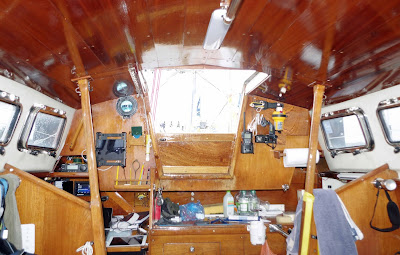 |
The new look saloon looking aft whilst work was in progress.
A teak face ply headlining was an option on new boats. |
Note (again) grab handles above the chart table, to the left of the hatch and centrally on the deck head all in addition to the standard "pillars" coming up from the half bulkhead. All are important for this aging singlehanded sailor, the cockpit is also littered with grab handles.
Some emergency gear - EPIRB, Knife, mobile VHF and torch is kept to port within easy reach of the hatch and a white "attention getting" flare and storage for my reading glasses is to starboard. Outboard of them is the mounting for one of my iPads or the laptop in tablet mode.
The galley is to port as is traditional - so that the cooker is below you when you heaveto on the starboard tack requiring yachts on port tack to keep clear, anything dropped then goes away from you. I have fitted a safety bar in front of the cooker, so you don't crash onto it and a safety belt to hold you in place when cooking or using the (double) sink in a seaway. For safety the Gas is remotely switched on and off from a switch by the cooker (not shown), there is also an automatic safety cut off in the gas locker.
The covers over the sinks and draining board and over the storage bin have a teak facing on one side and a heat resistant laminate on the other so they can be flipped over to be a heat resistant work surface when required.
Having space for a cooker with an oven (and a separate grill) makes a big difference to cookery afloat, especially finishing off long life part baked bread rolls etc. and making toast, reheating pies etc. but some A9m's just have hobs, usually gimbled and perhaps with a grill and have additional storage underneath, I stash bottles of water in the shallow bin under the cooker, which is convenient and makes good use of the space.
Ovens do however use quite a lot of gas, with heavy use about two cylinders during my two month solo round GB trip, fortunately there is dedicated, vented storage for 2 cylinders in the cockpit and a third cylinder will fit into the vented starboard cockpit locker.
The replacement of the headlining with Sapele (effectively African mahogany) makes for a cosy, warm interior, especially with my preferred oil lamp background lighting, not well caught in the picture due to the flash.
.
 |
The Chart table. The IridiumGo is hidden behind the laptop, the
gas alarm is partially hidden by the phone in its mount. |
 |
Sancerre when I first got her.
|
There is a proper chart table to starboard with chart storage within. The table hinges up to give access to the quarter berth under. On Sancerre I had to rebuild most of this area as a previous owner had taken much of it out and rebuilt the electrical panel in such a way that the chart table would no longer fit.
Above the chart table is the HF / MF/ LF SSB capable radio receiver. Behind the table in the centre is the Pioneer DAB/VHF/MF/SW radio with Bluetooth link to my iPad's and phone and a USB stick with lots of music on it. Below that are the mounts for the mobile phone and the IridiumGo satellite communicator. To the right a power point for the laptop and left, the "Meteoman" barograph with the gas detector below.
 |
The iPad showing a raster chart from Imray, now I use Admiralty
and Antares raster charts and the "Memorymap" application that
also works on the PC. |
I have an iPad that can be mounted above the chart table and marine radio or outside that can run:
At sea I have relevant backup paper charts. On the table with a laptop (held down by bungee cord) with Euronav charts and navigation software. That uses the GPS position, AIS information and other data from the network, a stand alone GPS dongle is also connected in case of a network failure and to allow multiple applications to have GPS via virtual com ports so if I really wanted to I could have Raster and Venctor charts showing together. Navtex information with navigational relevant info is flagged on the chart.
Outboard of the chart table is the electrical panel, most boats would originally have put electronics there as well but there was not much of it, no GPS, AIS or chart plotters and in the 70s very few boats, even 40 footers, had VHF as they were big and expensive. Usually it would be limited to a basic "rotary flashing LED" type echo sounder - most were not waterproof enough to go topside and if you had the money, a Brooks and Gatehouse radio receiver which was very good, although its hand held direction finding aerial was at best not very accurate. Being a single handed sailor I have most of my electronics that you need to look at mounted in the cockpit - which happens to be a good idea for crewed boats as well.
.JPG) |
The new electrical panel with the controller for the solar panels and the
wind generator centre and battery monitors top left. There are lots of USB
ports and 12V sockets around the chart table to keep multiple items charged.
|
 |
Fuses, most behind the drop down panel, and the CB switches are
arranged hierarchically to reduce the impact of wiring faults, not
I have had any since early 2018. |
Not requiring the berths which were too cramped for me to use, I converted the forepeak to a wet area and can store the 2.7m lightweight dinghy, two spinnakers and other items in there as well as an electric cool box, also various items in the port locker, the starboard locker used to hold the flexible fresh water tank.
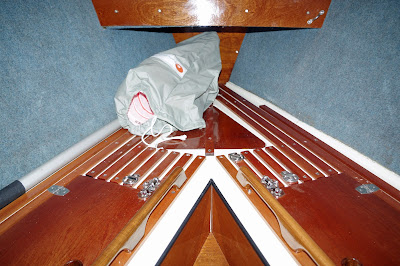 |
The modified forepeak, the anchor and chain locker is above the
storm jib in its sail bag. |
 |
The grey box, top right houses the contactor and control wiring
for the anchor windlass. When at sea I now normally store the dinghy
on the cabin roof to reduce weight forward, to leave room for the
heavy weather jib, fender boards and other gear. It also saves pulling
it through the fore hatch or the cabin. |
The rebuilt "Heads" after
I installer a holding tank in October 2023 with a drop down table (left), it is to port between the saloon and the forepeak, there is a hanging locker to starboard that on long trips I mainly use to stack waterproof bags full of cloths and towels.
Topside.
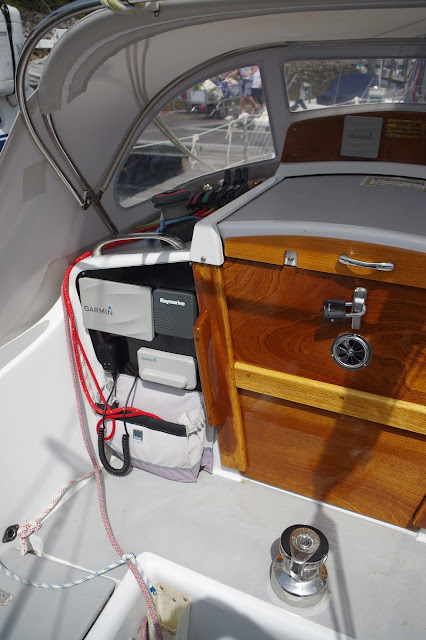 |
The forward end of the cockpit, electronics to port and above
the companion way. Someone spent some serious money on the
stainless Anderson headsail winch, at least only one was required.
|
The A9m is unusual in having a central single winch for the headsail, this works very well, especially short handed and surprisingly it does not get in the way going below providing the handle is not left in. There is some friction at the end of the tubes through the cockpit coaming but with the high side to the cockpit there would be friction what ever you did.

Having a large spinnaker and a powerful cruising chute I put two speed (30:1) self tailing winches on the cockpit coaming to handle them rather than use the rinky-dink but expensive stainless (10:1) ones further aft or the winches on the coach roof which are not self-tailing and would require the sprayhood to be lowered for effective use with a coloured sail.
The new winches could be used for the headsail (and are used for the heavy weather and storm jibs) but I much prefer to use the central winch for the genoa.
The double ended traveller lines would not normally be needed but the boat came with a replacement 4 part arrangement that did not work - the lines to the outboard blocks did not lead correctly and kept coming off and jamming so I simplified things by adding cleats to the traveller, the 3 part purchase is more than adequate.
The high coaming to the sides keeps the cockpit dry and the smallish well and lower coaming aft keeps it safe if it should flood after being "pooped". Having said that in over 20k miles I have only twice had waves breaking into the cockpit, both times over the quarter and neither resulted in more than a couple of inches of water in the cockpit.
The locker to starboard is shallow, being over the quarter berth, and is drained for storage of warps, petrol for the outboard and a third gas cylinder, that to port is deep and I use it for additional diesel, buckets etc. Aft the lazarette is huge with two smallish covers (pic below) that are awkward to access but OK for fenders, bags of rubbish, etc.
The circular pieces in the cockpit seats aft cover the gas bottle storage compartments, one per side, which are vented outboard via the cockpit drains - so all down hill if some of the heavier than air gas should escape, hopefully that will not happen as there is an
automatic shut off valve close to the cylinder along with a remotely controlled on/off valve. In the starboard cubby hole is the shore power connection, waterproof 12V and USB power points and the wired remote anchor windlass control, due to the need to flake chain into the locker that is only used to lower the anchor but very helpful on occasions when single handed. The matching cubby to port houses the engine control panel and engine stop.
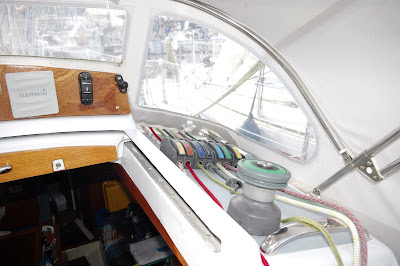 |
The small fitting at the right of the instrument panel supports
an iPad or the tablet PC, to the left of it is a waterproof USB power
point. Its not good in bright sunlight but otherwise either
replicating the plotter display or displaying raster charts and GPS
position it is an excellent way of keeping an eye on AIS, Radar (not
with Raster charts) and/or the boats position without getting a crick
in the neck. |
Sancerre has an unusually large number of clutches for the size of the boat. The 7 aside allow me to limit my time out of the cockpit and supports very efficient two line slap reefing for all three reefs. Single handed taking in the first reef only has the sail de-powered for 30 - 45 seconds upwind, quicker than many crewed boats that I see can manage, the double line system also permits reefing on any point of sailing. Other clutches handle halyards, topping lift and 3 general purpose foredeck lines used for the cruising chute tack line, pole down haul & fore guy, main preventer, removable forestay tension etc.
Sancerre's stern (2019/20) showing:
- The SeaFeather self steering gear.
- The gantry with 115 Watts of tilting solar panels, there is also a small panel on the cabin roof.
- The wind generator capable of producing 10 Amps with 20 knots over the deck.
 |
The outboard hoist. The fore-guy is
now rigged to a cockpit safety
ring for a lower, better angle. |
Broadband Radar.- Antennas for various pieces of kit, from port to starboard for the:
- HF/MF/LF marine receiver.
- Iridium Go Satellite system.
- Independent GPS for the AIS (Automatic Identification System).
- NavTex - a medium range (c300 mile) international system for navigational warnings, basic weather forecasts etc.
- Domestic Stereo (and emergency VHF).
- The starboard emergency boarding ladder (the yellow bag). The jackstays are set up so that they should be reachable from overboard, if they would then be usable by me in heavy weather is a mute point that I hope not to explore further.
- The board for the tender's outboard is now on the side of the push-pit so that the removable derrick / hoist that I built can lift it straight off and back on. I could manage my old light weight Seagull but the new four stroke outboard was too heavy for me and too expensive to risk dunking it in the water.

The foredeck is quite narrow with an anchor & chain locker forward. I have added a low profile windlass to save my back - a very worthwhile investment if you want to use anchorages rather than expensive marinas which can also be stressful to get in and out of single handed (more details on my page:
Anchors, Drogues and emergency steering - opens in new window). Storing the long spinnaker pole is a bit of a challenge, this is the best I could come up with. To the right you can see 2 of the 3 "Dorade" type ventilators, which help keep condensation in the saloon to a minimum but at least the leeward one needs to be closed in severe conditions.
Engines
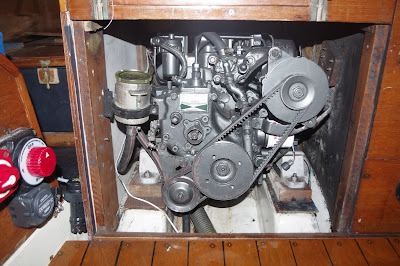 |
Sancerre's Yanmar 2GM20 sitting on upgraded (stiffer) mounts.
The non-standard toothed belt is needed to cope with the additional
demands on it caused by the external alternator regulator. |
The original standard engine fit was a single cylinder 8 HP Yanmar, with a 2:1 reduction gearbox driving a 12" x 8" propeller. Options were a single cylinder Volvo 7.5 HP or a twin 13 HP with sail-drive. After 40 years most will have been replaced.
Sancerre now has a directly cooled 2 cylinder Yanmar 2GM20 giving 16 HP continuous and with a 1 hour DIN rate of 18.2HP. The gearbox has a 2.62 reduction in forward, driving a right-handed, 3 bladed, 14" diameter propeller with a 13"pitch. With a reasonably clean hull fuel consumption is a very consistent 1.22 litres per hour at 5 - 5.4 knots and up to 1.45 litres per hour at c 6.1 knots.
Electrics
 |
Sancerre's #1 domestic battery bank, 2 x 120 Amp
Hour AGM batteries. Top right a galvanic Isolator
for the Shore power, below that the battery monitor
shunts for both domestic banks, a 3rd 120 AHr battery
is under the starboard bunk. Management of both
banks and the independent starter battery is automatic
using Digital Voltage Sensitive Relays (DVSRs) or
manual (for a tad more efficiency and to allow
isolation after a fault or during maintenance.). |
Sancerre is set up to be independent of shore power and can easily be operated for many days, without using the engine solely for battery charging. In practical terms when coastal sailing or operating cross channel it will never be needed as motoring in and out of anchorages or marinas will top the batteries up if there has been no wind or sun.
Unfortunately, it is not possible to make a realistic estimate of how often, if ever, engine charging would be needed on an oceanic passage as there are just too many variables. On the demand side two items, the autopilot and cool box can use a lot of power but how much on average is any ones guess, the autopilot can use 7 Amps in difficult conditions but usually much less and of course the wind vane steering uses none. The rather inefficient cool box can also use a lot but that depends on the outside temperature, how cool it is set for and how often it is opened. Either one can use more than the rest of the electrical items combined.
If the wind vane steering is used instead of the autopilot and use of the cool box minimised I could, without going below the recommended Depth of Discharge (DoD), operate for at least 4 days with everything else working and the solar and wind generators turned off. By minimising use of the PC, iPad, the plotter, Radar, etc. then it would be far longer.
On the supply side, Sancerre has solar panels rated at 150 Watts (about 12.5 Amps), but total output will be far lower than that unless they can point directly at a bright sun which rarely happens. The wind generator starts to produce power with about 7 knots of wind but needs 10 knots to produce 1.7 Amps, however on a breezy day sailing upwind it will produce 10.3 amps with 21 knots over the deck and 18.9 amps with 29 knots and, unlike the solar, it will work at night. The combined wind and solar regulator has two independent outputs, one for the domestic batteries and one for the 85 AHr AGM starter battery.
On the mooring or at anchor the renewables will normally keep the batteries charged indefinitely, even with some use of the diesel heater fitted for the 2022 season.
Unfortunately for reasons of space, originally compounded by differing battery sizes and a relatively low powered alternator (even with the external regulator) the domestic / service batteries are in two banks, more expensive with the need for extra switches etc., but it does provide a great deal of flexibility and back up. Charging can be automatically controlled with Digital Voltage Sensitive Relays or manually switched.
Summary:
|
Total domestic battery
capacity.
|
360 Amp Hours in two
banks, selectable. The original spec was one 86 AHr flooded battery for all purposes with the option of a second.
|
|
Usable capacity of domestic batteries to recommended
DoD
|
252 - 288 Amp Hours
|
|
Theoretical Solar
Capacity
|
150 Watts
|
|
Wind Turbine
|
10.3 Amps with 21 knots
over the deck.
|
|
Engine Alternator
|
55 Amps max, 30 – 40 Amps
for extended periods curtesy of an external regulator
|
Boat Documentation
Buyers Guide
For information about potential issue with the class see my
A9m buyers guide, here, or from the link on the right panel under "tips".














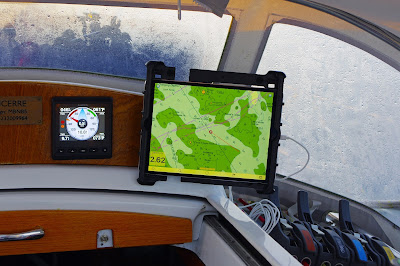








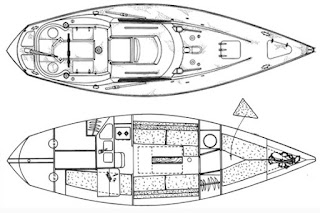








.JPG)








No comments:
Post a Comment